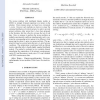Free Online Productivity Tools
i2Speak
i2Symbol
i2OCR
iTex2Img
iWeb2Print
iWeb2Shot
i2Type
iPdf2Split
iPdf2Merge
i2Bopomofo
i2Arabic
i2Style
i2Image
i2PDF
iLatex2Rtf
Sci2ools
ISBI
2009
IEEE
2009
IEEE
Improving M/EEG Source Localization with an Inter-Condition Sparse Prior
The inverse problem with distributed dipoles models in M/EEG is strongly ill-posed requiring to set priors on the solution. Most common priors are based on a convenient ℓ2 norm. However such methods are known to smear the estimated distribution of cortical currents. In order to provide sparser solutions, other norms than ℓ2 have been proposed in the literature, but they often do not pass the test of real data. Here we propose to perform the inverse problem on multiple experimental conditions simultaneously and to constrain the corresponding active regions to be different, while preserving the robust ℓ2 prior over space and time. This approach is based on a mixed norm that sets a ℓ1 prior between conditions. The optimization is performed with an efficient iterative algorithm able to handle highly sampled distributed models. The method is evaluated on two synthetic datasets reproducing the organization of the primary somatosensory cortex (S1) and the primary visual cortex (V1),...
| Added | 19 May 2010 |
| Updated | 19 May 2010 |
| Type | Conference |
| Year | 2009 |
| Where | ISBI |
| Authors | Alexandre Gramfort, Matthieu Kowalski |
Comments (0)

